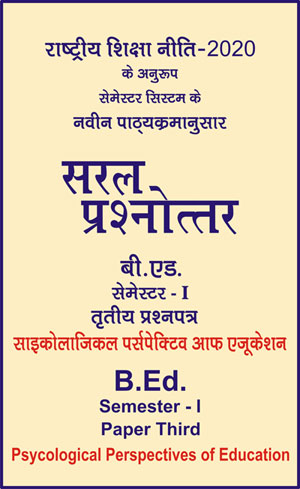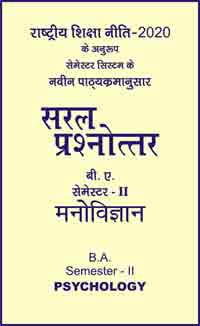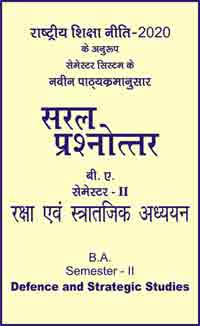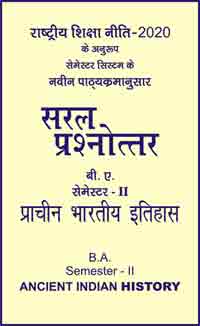|
बी एड - एम एड >> बी.एड. सेमेस्टर-1 प्रश्नपत्र-III - साइकोलाजिकल पर्सपेक्टिव आफ एजूकेशन बी.एड. सेमेस्टर-1 प्रश्नपत्र-III - साइकोलाजिकल पर्सपेक्टिव आफ एजूकेशनसरल प्रश्नोत्तर समूह
|
5 पाठक हैं |
|||||||
बी.एड. सेमेस्टर-1 प्रश्नपत्र-III - साइकोलाजिकल पर्सपेक्टिव आफ एजूकेशन (अंग्रेजी भाषा में)
Question- Explain Skinners Operant Conditioning. (Kanpur 2006)
Or
Explain briefly the learning theory propounded by B.F. Skinner. (Kanpur 2016)
Or
Describe operant conditioning theory of learning of B.F. Skinner. Explain its contribution to education.
Answer-
Skinner’s Operant Conditioning
Classical conditioning is the theory of conditioning propounded by Pavlov. Conditioning approaches have been classified as classical conditioning known by the name of Pavlov. Operant conditioning is known by the work of Skinner. Skinner’s system of operant conditioning is a descriptive behaviourism which seems to establish the laws of behaviour through the study of operant learning. An operant is an emitted response, in contrast to respondents, a class of behaviour studied by the technique of classical conditioning utilized by Pavlov. B.F. Skinner, the America psychologists, pointed out, in contrast to the classical conditioning by Pavlov that operants may be studied independently of the stimulus conditions that give rise to them. Indeed, in the usual case the stimulus may be unknown. The experimental arrangement for studying operant behaviour in the laboratory consists of what has come to be known as Skinner box. The Skinner box is an enclosure in which the animal is maintained free from distracting stimuli and in which he can receive a reinforcement upon emitting the proper operant conditioning. In the case of the rat, the operant is a bar press, and the reinforcement is a pallet of food. As many times as the rat presses the bar, a magazine will deliver a pallet and conditioning will proceed at a rapid rate. More recently, the pigeon has come into extensive use in the Skinner box. In this case the operant is pecking at a dot and the reinforcement is a measured bout of grain.
The fundamental law of operant conditioning is that if the occurrence of an operant is followed by a reinforcing stimulus, it will increase the rate of responding. The rate of responding is typically measured during a run to extinction, since the time consuming process of eating during the reinforcing series obscures the rate of responding. These reinforcers may be both positive and negative. Positive reinforcers are the stimuli such as food, water or sexual contact. These directly increase the probability of a response. On the other hand, negative reinforcers strengthen the probability of a response only when they are removed from the situation. Examples of negative reinforcers are electric shocks, bright lights, loud noises, etc.
The most important variable associated with reinforcement is the time schedule on which the reinforcing stimulus is delivered. Continuous reinforcement is the regular presentation of the reinforcement with each operant response. Intermittent reinforcement is irregular reinforcement delivered according to a predetermined time schedule. There are two important types of intermittent reinforcement, interval and fixed ratio. In interval reinforcement, the reinforcement is given at certain fixed intervals of time such as every two minutes, regardless of how frequently the animal responds. Under such conditions, the periodic reinforcement and the shorter intervals yield the highest rates of responding. On the other hand, in ratio reinforcement, the animal is given reinforcement, after a certain number of responses. For example, the pigeon might get a portion of grain only after pecking ten times. In ratio reinforcement very high rates of responding can be maintained with high ratios, provided these are approached gradually. Reinforcement schedules may also be arranged as variable intervals or variable ratios under special research conditions. Secondly reinforcement occurs when a stimulus, not originally a reinforcer becomes reinforcing through association with a reinforcing stimulus. For example, if a weak light is flashed each time, the reinforcement is delivered upon the pressing of the bar by the animal, the light will come to have reinforcing qualities. It can be used to maintain bar.
Skinner’s basic techniques of operant conditioning have been extended into the use of human teaching machines that operate on the principle of self-reinforcing learning. The use of reinforcement shows that human symbolic behaviour can be learnt according to the same principles that apply to more elementary forms of learning. Skinner and his associates have attempted to extend their method of operant conditioning into the field of behaviour therepy. In all his studies upon animals, Skinner used a box like structure in which the correct operant of mechanism brings the animal a reward. This was known as Skinner box. In some boxes, elaborate controls are maintained upon temperature, humidity, external sound, lights and orders. With small animals, the operation in the Skinner box requires the pressing of a bar. With bird, it requires the pecking of a spot.
Contribution of B.F. Skinner - In the field of education Skinner has contributed as under -
-
Skinner developed operant conditioning theory, which is built up into the idea that our behaviours are based on specific reaction of events in our environment.
-
Skinner has developed the distinction of calling reinforcement to the reward obtained. It is an important element of his theory.
-
Skinner has made his vision of behaviour as a fundamental behaviour. Behavioural science believes that behaviour is the result of an environmental history. The vision of behaviour is called Skinner’s radical behaviourism.
-
Skinner has defined retention of reinforcement behaviour which is the primary process of shaping and controlling behaviour and occurs in two ways - ‘positive’ or ‘negative’.
-
Skinner transformed the theory of Thorndike’s into ‘SR’ principle in ‘RS’. He believed that the action should be done and student should be reinvigorated immediately.
|
|||||














